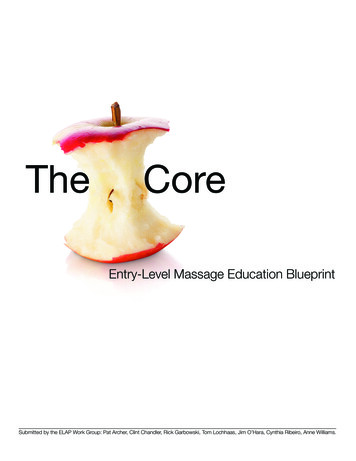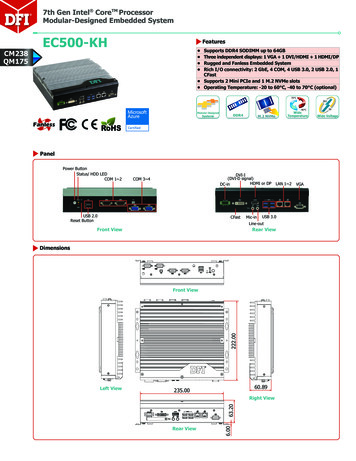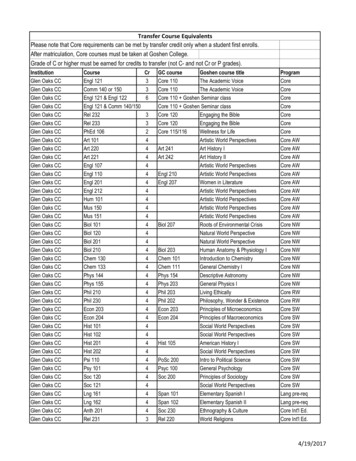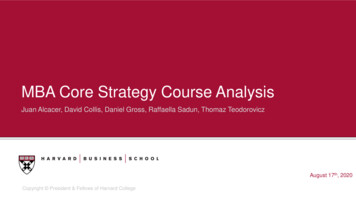
Transcription
TheCoreEntry-Level Massage Education BlueprintSubmitted by the ELAP Work Group: Pat Archer, Clint Chandler, Rick Garbowski, Tom Lochhaas, Jim O’Hara, Cynthia Ribeiro, Anne Williams.
The Core: Entry-Level Massage Education Blueprint 2013 Coalition of National Massage Therapy Organizations: Alliance for Massage TherapyEducation, American Massage Therapy Association, Associated Bodywork & MassageProfessionals, Inc., Commission on Massage Therapy Accreditation, Federation of StateMassage Therapy Boards, Massage Therapy Foundation, and National Certification Board forTherapeutic Massage & Bodywork, Inc. ALL RIGHTS RESERVED. The Core: Entry-Level MassageEducation Blueprint was co-authored by Pat Archer, Clint Chandler, Rick Garbowski, TomLochhaas, Jim O’Hara, Cynthia Ribeiro, and Anne Williams.Printed and published in the United States of AmericaThe Coalition of National Massage Therapy Organizations encourages wide readership of thisreport and its companion document The Core: Entry-Level Analysis Project Report, and herebygrants permission to use, copy, and distribute these materials for educational purposes only,provided a copyright notice is affixed in the form furnished above.December 18, 2013
shaveresultedinanextraordinary,ground- pyprofessionthatenhancesthehealthandwell- anization’sself- gingatthetopofthelistweretwoconcerns: inconsistentquality,depthandfocusofentry- ‐levelmassagetherapyeducation;and try- ifyingEntry- y- ‐levelmassagetherapyinstructionalprograms–the1
s.Theproposalrecommendedformationofaseven- earch- othejobthoroughly.Intheend,itprovedtobea21- henextseveralyearsinalleviatingbothentry- cerns.TheprojectwastitledEntry- eeducation,butalsosomewide- d- ycare2
providersrecognizethepowerofevidence- :Entry- veryentry- wo- anizations,endorseeveryspecificrecommendedsub- ‐topic,activity,orproposedweightinginthereport.3
geofTheCore:Entry- cumentTheCore:Entry- backontheinitialdraft,tolong- basedonwaysinwhichthehandsandotheranatomicaltools manipulate d- sforsubjects,topics,andsub- inetimeframes.4
ortanttonotethattoday40%- evolvinglifecircumstancesfor20- owledgeandskill5
atwilloutweighanyincreaseintuitionfroma500- bepartofeveryentry- edthatoneformofhands- nemphasisonpractical,real- omswitheffectivestrategiestosupportadultlearning.6
OurdesireisthatTheCore:Entry- urorganizationsdonothavethepowertoforcethere- uenceseveralprofessionaudiences: ngteacher- oviders,whowanttomakereferralstoconsistentlywell- ‐educatedmassagetherapists,andfinallytheend- ore.7
tificationBoardforTherapeuticMassage&Bodywork8
Entry-Level Massage Education BlueprintTotal Hours: 625Please note that the hours tabulated for each topic and subject are based on minimumclassroom learning hours. The addition of 10 minutes of break time for every hour of lecturetime has been added to all lecture hours. The addition of time for set-up, change-over, andcleanup has also been added to activities, demonstrations, and exchanges. Please use AppendixC (Hours Rationale) in the Entry-Level Analysis Project Report for additional information.Table of Contents1. Introduction to the Entry-Level Massage Education BlueprintTerminologyInstructional Design BasicsThe ELAP Learning TaxonomyLearning Objectives and OutcomesLearning ExperiencesAbilities in Massage EducationThe ELAP Blueprint Structure2. Summary of Learning Outcomes3. Subject: Massage Theory and Principles (27.0)Topic: Evolution of Massage and Bodywork (1.5)Sub-Topic: Historical Roots of MassageSub-Topic: Massage and Bodywork TodayTopic: Research Literacy (3.0)Sub-Topic: Evidence-Informed PracticeSub-Topic: Basics of Research 2013 Coalition of National Massage Therapy OrganizationsPage 1
Topic: Massage Benefits and Effects (7.0)Sub-Topic: Types of Benefits and EffectsSub-Topic: Physiological Benefits and EffectsSub-Topic: Psychological and Other Benefits and EffectsSub-Topic: Massage IndicationsTopic: Massage Cautions and Contraindications (15.5)Sub-Topic: Endangerment AreasSub-Topic: ContraindicationsSub-Topic: Medications and MassageSub-Topic: American Red Cross Adult First Aid/CPR/AED Certification4. Subject: Massage Professional Practices (20.0)Topic: Massage Equipment and Environment (2.5)Sub-Topic: Equipment and SuppliesSub-Topic: Session EnvironmentsTopic: Preventing Disease Transmission (5.5)Sub-Topic: Understanding DiseaseSub-Topic: Therapist HygieneSub-Topic: Infection ControlSub-Topic: Standard PrecautionsTopic: Laws and Regulations (4.0)Sub-Topic: Obtaining and Maintaining CredentialsSub-Topic: Adhering to Laws and RegulationsSub-Topic: Supervision of TherapistsTopic: Personal Health, Body Mechanics, and Self-Care (8.0)Sub-Topic: Personal Health and Self-CareSub-Topic: Body Mechanics PrinciplesSub-Topic: Preventing Work-Related Injury 2013 Coalition of National Massage Therapy OrganizationsPage 2
5. Subject: The Therapeutic Relationship (40.0)Topic: The Relationship of Therapist and Client (4.0)Sub-Topic: Characteristics of Positive Therapeutic RelationshipsSub-Topic: Preventing Transference and CountertransferenceTopic: Ethics and the Therapeutic Relationship (18.0)Sub-Topic: Ethical PrinciplesSub-Topic: Code of Ethics and Standards of Ethical PracticeTopic: Boundaries in the Therapeutic Relationship (18.0)Sub-Topic: Establishing and Maintaining Professional BoundariesSub-Topic: Managing Emotions in a Therapeutic RelationshipSub-Topic: Managing Intimacy, Touch, and Sexual Arousal Responses6. Subject: Anatomy, Physiology, and Pathology (80.0)Topic: Orientation to the Human Body (13.0)Sub-Topic: Using Anatomic and Health Care TerminologySub-Topic: Chemistry, Organization, and Organ SystemsSub-Topic: Structure and Function of CellsSub-Topic: Structure and Function of Tissues and MembranesSub-Topic: An Overview of Health and DiseaseTopic: The Integumentary System (5.0)Sub-Topic: The Structure and Function of the Integumentary SystemSub-Topic: Pathologies of the Integumentary SystemTopic: The Skeletal System (10.0)Sub-Topic: The Skeleton and BonesSub-Topic: JointsSub-Topic: Pathologies of the Skeletal SystemTopic: The Fascial System (6.0)Sub-Topic: The Structure and Function of the Fascial SystemSub-Topic: Fascial Dysfunctions 2013 Coalition of National Massage Therapy OrganizationsPage 3
Topic: The Muscular System (13.0)Sub-Topic: The Structure and Function of the Muscular SystemSub-Topic: Muscle ContractionsSub-Topic: Pathologies of the Muscular SystemTopic: The Nervous System (16.0)Sub-Topic: The Structure and Function of the Nervous SystemSub-Topic: The Peripheral Nervous SystemSub-Topic: The Central Nervous SystemSub-Topic: The Anatomy of PainSub-Topic: Pathologies of the Nervous SystemTopic: The Cardiovascular System (4.0)Sub-Topic: The Structure and Function of the Cardiovascular SystemSub-Topic: Pathologies of the Cardiovascular SystemTopic: Other Body Systems (13.0)Sub-Topic: The Lymphatic SystemSub-Topic: The Immune SystemSub-Topic: The Digestive SystemSub-Topic: The Respiratory SystemSub-Topic: The Endocrine SystemSub-Topic: The Reproductive SystemSub-Topic: The Urinary System 2013 Coalition of National Massage Therapy OrganizationsPage 4
7. Subject: Assessment and Documentation (50.0)Topic: Client Assessment (43.5)Sub-Topic: Overview of Assessment in Massage and BodyworkSub-Topic: Health Forms and Client InterviewsSub-Topic: General Observation and Client Level of HealthSub-Topic: Palpation AssessmentSub-Topic: Posture AssessmentSub-Topic: Range of Motion AssessmentSub-Topic: Pain AssessmentSub-Topic: Functional Limitations AssessmentTopic: Documentation and Client Files (6.5)Sub-Topic: Key Principles of Documentation and Keeping Good Client filesSub-Topic: SOAP Charting and Other Documentation Formats8. Subject: Massage and Bodywork Application (175.0)Topic: Foundation Principles and Skills (13.0)Sub-Topic: Overview of Massage and Bodywork Forms and StylesSub-Topic: Positioning Clients for Comfort and SafetySub-Topic: Draping MethodsTopic: Application Methods (82.0)Sub-Topic: Core Concepts in Massage and Bodywork ApplicationSub-Topic: Forces and Soft-Tissue DeformationSub-Topic: Gliding MethodsSub-Topic: Torsion MethodsSub-Topic: Shearing MethodsSub-Topic: Elongation MethodsSub-Topic: Oscillating MethodsSub-Topic: Percussive MethodsSub-Topic: Static MethodsSub-Topic: Joint Movement MethodsSub-Topic: Hot and Cold Methods 2013 Coalition of National Massage Therapy OrganizationsPage 5
Topic: The Massage or Bodywork Session (30.0)Sub-Topic: Overview of the Events in a Massage or Bodywork SessionSub-Topic: Integrating Methods into a Form and Session PlanSub-Topic: Customization of the Session to Meet Client Wants and NeedsSub-Topic: Suggesting Client Self-CareNote: Schools can choose to integrate application methods using a Western or Easternapproach or an approach based on their philosophy of massage or bodywork (50 hourstotal). The ELAP Work Group recommends Swedish massage, myofascial approaches,and neuromuscular approaches because profession stakeholder survey results indicatethat these forms are those most widely practiced and valued by professional massagetherapists. Swedish massage and “deep tissue” (which incorporates methods frommyofascial and neuromuscular approaches) are the forms most widely requested byconsumers.Sample Forms: 50 hours totalTopic: Sample Form: Western Integration of Application MethodsSub-Topic: Swedish MassageSub-Topic: Myofascial ApproachesSub-Topic: Neuromuscular ApproachesTopic: Sample Form: Eastern Integration of Application MethodsSub-Topic: Basic Concepts of Traditional Chinese/Japanese MedicineSub-Topic: ShiatsuSub-Topic: TuinaSub-Topic: Thai Massage 2013 Coalition of National Massage Therapy OrganizationsPage 6
9. Subject: Palpation and Movement (71.0)Topic: Orientation to Palpation and Movement (4.0)Sub-Topic: Developing Palpation SkillsSub-Topic: Basics of Human MovementTopic: The Shoulder and Arm (9.5)Sub-Topic: Bones and Bony LandmarksSub-Topic: Joints, Ligaments, and Range of MotionSub-Topic: Muscles and their ActionsTopic: The Elbow, Forearm, Wrist, and Hand (9.5)Sub-Topic: Bones and Bony LandmarksSub-Topic: Joints, Ligaments, and Range of MotionSub-Topic: Muscles and their ActionsTopic: The Spine and Thorax (9.5)Sub-Topic: Bones and Bony LandmarksSub-Topic: Joints, Ligaments, and Range of MotionSub-Topic: Muscles and their ActionsTopic: The Head, Neck, and Jaw (9.5)Sub-Topic: Bones and Bony LandmarksSub-Topic: Joints, Ligaments, and Range of MotionSub-Topic: Muscles and their ActionsTopic: The Pelvis and Hip (9.5)Sub-Topic: Bones and Bony LandmarksSub-Topic: Joints, Ligaments, and Range of MotionSub-Topic: Muscles and their ActionsTopic: The Thigh and Knee (9.5)Sub-Topic: Bones and Bony LandmarksSub-Topic: Joints, Ligaments, and Range of MotionSub-Topic: Muscles and their ActionsTopic: The Leg, Ankle, and Foot (9.5)Sub-Topic: Bones and Bony LandmarksSub-Topic: Joints, Ligaments, and Range of MotionSub-Topic: Muscles and their Actions 2013 Coalition of National Massage Therapy OrganizationsPage 7
10.Subject: Adapting Sessions for Clients (80.0)Topic: Adapting Sessions for the Stages of Healing (11.0)Sub-Topic: An Overview of the Inflammatory Response and Healing CycleSub-Topic: The Acute Stage of HealingSub-Topic: The Subacute Stage of HealingSub-Topic: The Maturation Stage of HealingTopic: Adapting Sessions for Clients with Common Pathologies (40.0)Sub-Topic: Sessions for Clients with ArthritisSub-Topic: Sessions for Clients with BursitisSub-Topic: Sessions for Clients with CancerSub-Topic: Sessions for Clients with DiabetesSub-Topic: Sessions for Clients with FasciitisSub-Topic: Sessions for Clients with FibromyalgiaSub-Topic: Sessions for Clients with HeadachesSub-Topic: Sessions for Clients with Nerve Compression SyndromesSub-Topic: Sessions for Clients with OsteoporosisSub-Topic: Sessions for Clients with Skin CancerSub-Topic: Sessions for Clients with SprainsSub-Topic: Sessions for Clients with StressSub-Topic: Sessions for Clients with StrainsSub-Topic: Sessions for Clients with TendinopathiesTopic: Adapting Sessions for Special Populations (29.0)Sub-Topic: Sessions for Clients Who Are Over 55Sub-Topic: Sessions for Clients Who Are ObeseSub-Topic: Sessions for Clients Who Are ChildrenSub-Topic: Sessions for Clients Who Are PregnantSub-Topic: Sessions for Clients Who Are Athletes or Fitness OrientedSub-Topic: Sessions for Clients Who Are at the End of LifeSub-Topic: Sessions for Clients with Disabilities 2013 Coalition of National Massage Therapy OrganizationsPage 8
11.Subject: Career Development (82.0)Topic: Interpersonal Skills (7.0)Sub-Topic: CommunicationSub-Topic: Conflict ResolutionTopic: Student Clinic (50.0)Sub-Topic: ProfessionalismSub-Topic: Session ManagementSub-Topic: Clinic ManagementSub-Topic: Sessions with ClientsTopic: Career Planning (25.0)Sub-Topic: Envisioning a Massage and Bodywork CareerSub-Topic: EmploymentSub-Topic: Private Practice12. Massage Learning in the Affective DomainTopic: Value LearningTopic: Value ClientsTopic: Value OneselfTopic: Value Other ProfessionalsTopic: Value the Profession13. Massage Learning in the Interpersonal Domain 2013 Coalition of National Massage Therapy OrganizationsPage 9
Entry-Level Massage Education BlueprintIntroduction to the BlueprintTerminologyInstructional Design BasicsThe ELAP Learning TaxonomyLearning Objectives and OutcomesLearning ExperiencesAbilities in Massage EducationThe Blueprint StructureConclusions 2013 Coalition of National Massage Therapy OrganizationsPage 10
The Entry-Level Analysis Project (ELAP) Entry-Level Massage Education Blueprint (Blueprint) outlines thesuggested learning outcomes and learning objectives all people becoming professional massagetherapists should achieve, regardless of specialization, to ensure they can work safely and competentlyin their careers. Created by the ELAP Work Group, the Blueprint also informs the Work Group’srecommended total number of minimum hours of entry-level education.The Blueprint may prove a useful starting place for schools that wish to evaluate and evolve theircurricula. The strong instructional design that underlies the Blueprint illuminates how people learn tosupport instructor best practices in the development of classroom activities, written materials, andeducational experiences. The data-informed recommendations for key terms and concepts, hands-onskills, and effective and appropriate language and behaviors; the proper educational scaffoldingilluminated by progressive learning objectives; the examples of educational experiences used
Massage Therapy Boards, Massage Therapy Foundation, and National Certification Board for Therapeutic Massage & Bodywork, Inc. ALL RIGHTS RESERVED. The Core: Entry-Level Massage Education Blueprint was co-authored by Pat Archer, Clint Chandler, . !fromeach!organization!participated!in!










